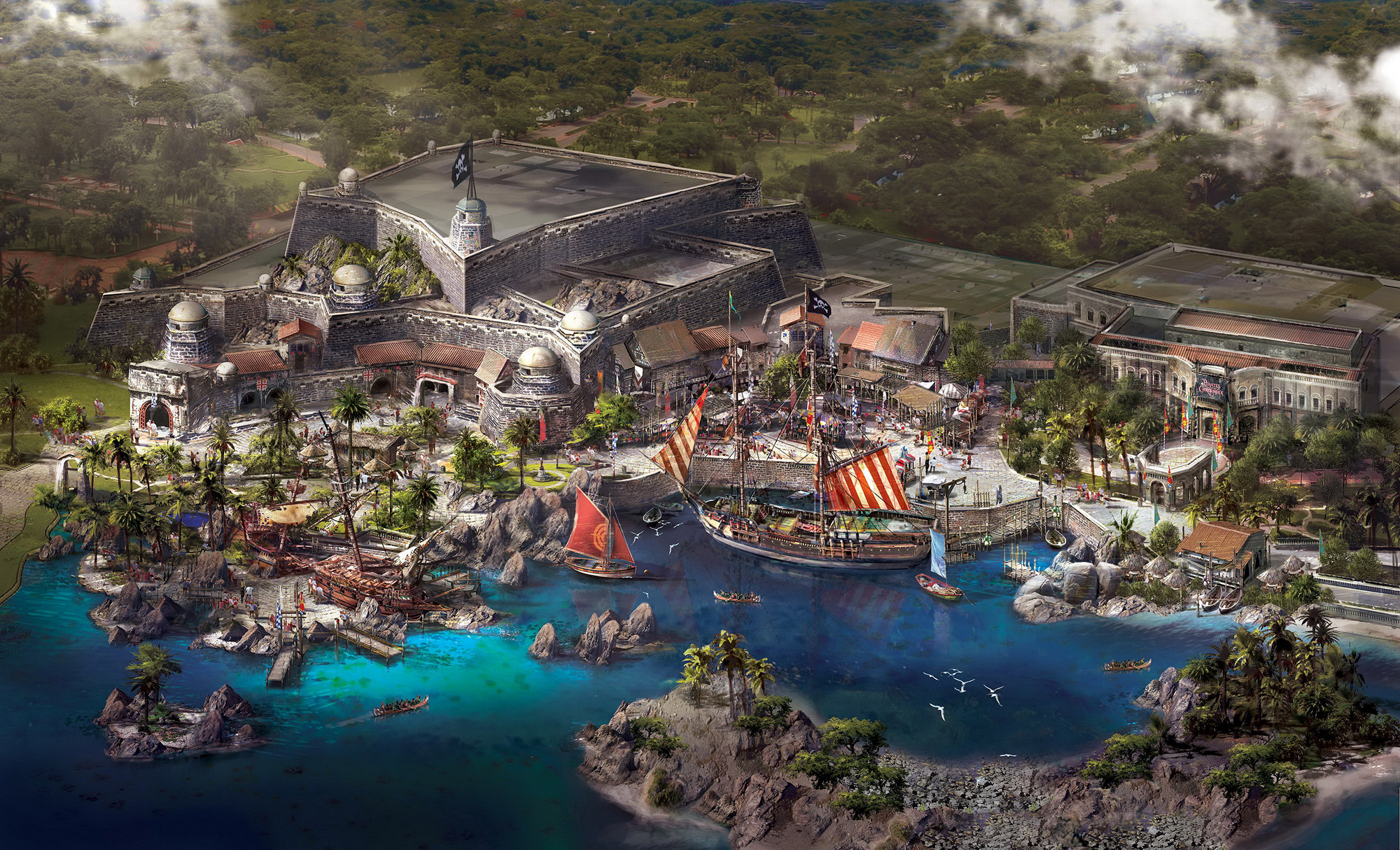JUMP TO ENGLISH TEXT, CLICK HERE!
Cette semaine, le PDG de Disney Bob Iger a présenté le traditionnel meeting annuel des actionnaires de la Walt Disney Company. Entre diverses annonces, il a notamment révélé un impressionnant concept art de Shanghai Disneyland : un land entier consacré aux pirates. Si l’execution est fidèle à l’illustration, la thématisation de Shanghai Disneyland devrait effectivement être aussi extravagante et minutieusement détaillée qu’à Tokyo DisneySea.
Cette zone pirates Cove sera aussi la première des parcs Disney a être inspirée des films Pirates of the Caribbean. Un aspect qui devrait caractériser l’ensemble du parc de Shanghai, où les licences maison seront exploitées abondamment, plus que dans aucun parc Disney auparavant. Personnellement, je trouve assez logique de construire des attractions basées sur les films : après tout on vient chez Disney pour voir du Disney. Tant qu’elles peuvent cohabiter avec des attractions non inspirées de licences (comme les maisons hantées, Big Thunder Mountain, Expedition Everest…), je trouve cela tout à fait légitime. Là où je me pose plus de questions, c’est sur cette tendance récente à thématiser des lands entiers sur une seule et unique licence cinématographique, comme CarsLand, Wizarding World of Harry Potter à Universal et donc bientôt Pirates of the Caribbean à Shanghai Disneyland.
Que deviendront ces investissement gargantuesques dans 20, 30, 40, 50 ans? Toutes les licences hollywoodiennes, n’ont pas l’intemporalité ou la fanbase de Star Wars par exemple. Pas même les plus rentables. Alors que les parcs Disney s’apprêtent à célébrer les 50 ans d’ “It’s a small world!” et que Disneyland (Californie) vient de rénover profondément Big Thunder Mountain Railroad, toujours aussi populaire après 34 ans, je me demande si ces zones gigantesques ne deviendront pas un gros problème une fois que ces franchises auront été remplacées par de nouvelles productions dans le coeur et l’imaginaire collectif du public.
En tout cas, la stratégie menée par Bob Iger semble cohérente : aucune histoire n’est close définitivement. Le meilleur exemple : les suites de films Pixar qui arrivent près de 10 ans après le premier volet n’ont d’autre objectif que de faire vivre la franchise. Pas seulement pour gagner de l’argent en salles de cinéma et DVD mais aussi pour faire perdurer une licence dans le temps. Afin d’éviter que les énormes investissements dans les parcs ne deviennent obsolètes trop tôt – entre autres activités lucratives. Mais cette stratégie suffira-t-elle a éviter que ces grands lands entièrement dédiés à une seule et unique licence restent pertinents pour les 50 prochaines années? On débrieffe ça dans 50 ans.
Sur le même sujet, je vous invite à relire ces anciens posts sur la guerre des franchises dans les parcs à thèmes:
Transformers The Ride looks ugly (and other thoughts on franchise frenzy)
Shanghai Disneyland breaks the ground. And the rules.
Avatar movie franchise arrives to Disney Parks
This week, Disney CEO Bob Iger hosted the annual shareholders meeting of The Walt Disney Company. Among various announcements, he revealed an impressive Shanghai Disneyland concept art showing an entire pirates based land. If the execution is like this rendering, the theming and scenery of Shanghai Disneyland promises to be as extravagant and detailed as Tokyo DisneySea.
This Pirate area will also be the first one to be based on the Pirates of the Caribbean movie franchise. This will be a major characteristic of the Shanghai park, where licences should be extensively used, more than in any Disney park before. If you ask me, I think it’s quite logical to build movie based attractions : after all you come to Disney to see Disney stuff. As long as they can live together with non franchise based attractions (like the many iterations of the haunted houses, Big Thunder Mountain, Expedition Everest…) I think it’s all legit. But I’m not sure what to think about this recent trend of entire, large scale lands based on a single movie licence, like CarsLand, Wizarding World of Harry Potter at Universal and now Pirates of the Caribbean in Shanghai Disneyland.
What will these massive investments become in 20, 30 40, 50 years from now? Not every Hollywood franchise has the ‘timelessness’ or the huge fanbase of Star Wars for instance. Not even the most profitable ones. As the Disney parks are about to celebrate the 50th anniversary of “It’s a small world” and Disney just spent a year renovating Big Thunder Mountain Railroad, still very popular after 34 years of service, I wonder if those new gigantic lands won’t become a big problem once the franchises they’re based on will be replaced by newer ones in the heart and collective imagination of the public.
By and large, the strategy of Bob Iger seems coherent : there is no definitive ending to a story anymore. The best example is these Pixar sequels that arrive a decade after the first movie. They have only one purpose : make the franchise live. Not only to earn money in theaters and on home video but also to make a licence live longer. In order for these whopping park investments to not become obsolete too early – among other lucrative things. Will this strategy actually allow these giant single-franchise-based lands to stay relevant for the next 50 years? Well, let’s debrief in 50 years.
If you want to read more on this topic, I kindly invite you to jump to these previous posts on the current franchise war in theme parks:
Transformers The Ride looks ugly (and other thoughts on franchise frenzy)


2 Comments